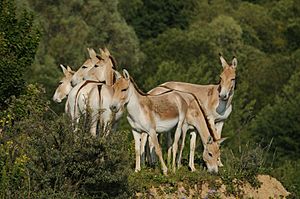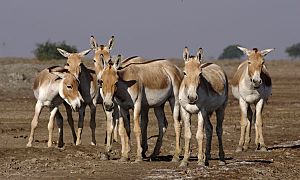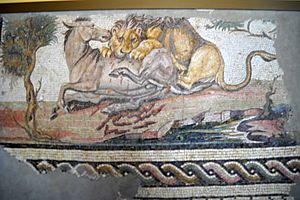Onager facts for kids
The Onager (Equus hemionus) is a large mammal from the horse family, Equidae. It is sometimes called the Asian Wild Ass. Onagers live in the deserts of places like Syria, Iran, Pakistan, Israel, and western China.
Quick facts for kids Onager |
|
|---|---|
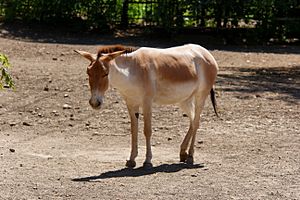 |
|
| A Persian onager (Equus hemionus onager) at Rostov-on-Don Zoo, Russia. | |
| Conservation status | |
| Scientific classification | |
| Subspecies | |
|
|
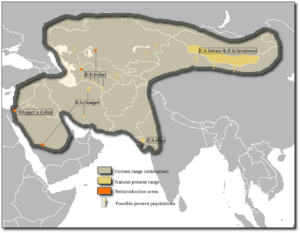 |
|
| Equus hemionus range | |
| Synonyms | |
|
Equus onager Boddaert, 1785 |
Contents
What Do Onagers Look Like?
Onagers look a lot like horses. They have shorter legs than horses. Their fur color changes with the seasons. In summer, they are reddish-brown. In winter, they become yellowish-brown or grayish-brown.
They have a black stripe down their back. This stripe has white borders. Their belly, rump, and muzzle are usually white. However, the Mongolian wild ass has a wider black stripe.
Onagers are bigger than donkeys. They weigh about 200 to 290 kilograms (440 to 640 pounds). Their body length is about 2.1 to 2.5 meters (7 to 8 feet). Male onagers are generally larger than females.
Onager Life and Habits
Asian wild asses are most active during dawn and dusk. This is true even when it is very hot.
How Onagers Live Together
Like most animals in the horse family, onagers are social. Male onagers, called stallions, might live alone. They can also live in small groups of two or three. Sometimes, males gather groups of females. In other cases, dominant males protect areas to attract females. How they live together can change. This depends on the weather, plants, and if predators are around.
The way Asian wild asses behave socially can be quite different. This depends on their habitat and any dangers.
Onagers in the Middle East and South Asia often live in territories. These areas might overlap a little. Dominant males have home ranges of about 9 square kilometers (3.5 square miles). These areas can be much larger too. They include places to eat, rest, and find water. Water sources are usually at the edge of their territory.
Females with young sometimes form small groups. Their areas can be up to 20 square kilometers (7.7 square miles). These areas overlap with other groups and male territories. This is similar to how Grévy's zebras live.
Onager Reproduction and Life Cycle
Asian wild asses can have babies when they are two years old. They usually mate for the first time at three or four years old.
They breed during certain seasons. The mother carries the baby for 11 months. Giving birth takes a little over 10 minutes.
A baby onager can stand and drink milk within 15 to 20 minutes. Mothers with young often form groups of up to five females. The mother stays close to her baby. She will keep other animals away, even her older offspring. Sometimes, males in the wild will chase away the young. This allows them to mate with the mother again. Wild Asian wild asses can live up to 14 years. In zoos, they can live up to 26 years.
What Onagers Eat
Onagers are herbivores, meaning they eat plants. They eat grasses, herbs, leaves, and fruits. They also eat salty plants when they can find them. In dry places, they eat shrubs and trees. They have been seen eating seed pods. They also break up woody plants with their hooves. This helps them reach softer plants growing underneath.
In winter, onagers eat snow when they cannot find water. If there are no natural water sources, they dig holes in dry riverbeds. This helps them find water underground. Other animals, including farm animals, often use these water holes too. Onagers also get water from the plants they eat.
In Mongolia, during spring and summer, juicy plants are a big part of their diet.
Who Hunts Onagers?
Onagers are hunted by predators like Persian leopards and striped hyenas. Some onager deaths from leopards have been seen in Iran. Persian leopards are large and strong enough to hunt Asian wild asses.
In the past, Asiatic lions and tigers were the main predators of onagers. They were also hunted by Asiatic wild dogs and Asiatic cheetahs. Bears might have hunted onager babies. In India, mugger crocodiles can be a danger to onagers. This happens when onagers cross rivers during their travels.
Today, gray wolves are the biggest predators of onagers. About 23% of what gray wolves eat is Asian wild asses. However, like most horse-like animals, onagers protect themselves. Groups of male onagers work together to chase away predators. If they feel threatened, onagers will defend themselves. They kick violently at any animal that attacks them.
Images for kids
See also
 In Spanish: Onagro para niños
In Spanish: Onagro para niños





